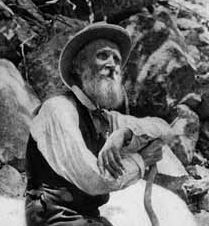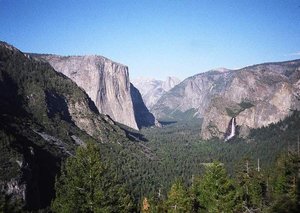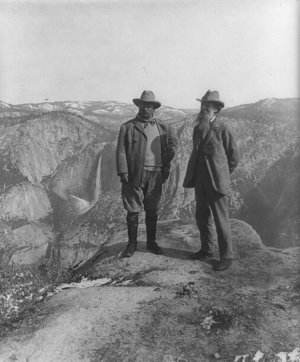John Muir
|
|
John Muir (April 21, 1838 – December 24, 1914) was an environmentalist, naturalist, traveler, writer, and scientist. He is, however, probably best remembered as one of the greatest champions of the Yosemite area's natural wonders. He thought that nature was a primary source revealing the character of God and that the Sierra Nevada was sacred ground, even calling it the "Range of Light." Anticipating the animal rights movement, Muir argued with vigor about what he considered the questionable ethics of hunting (calling it the "murder business"). He also anticipated modern conservation biologists by recognizing that everything in nature is connected and that the preservation of large tracts of unfragmented wilderness was the only real way to ensure a healthy ecosystem. Because of this, he argued for the protection of entire river drainages, instead of isolated valleys.
| Contents |
Biography
Muir was born in the historic burgh of Dunbar, East Lothian, Scotland to Daniel Muir and Ann Gilrye. He had two brothers, Daniel and David, and, after 1850, five sisters, Margaret, Sarah, Mary, Anna, and Joanna.
Muir immigrated to the United States in 1849, when his family started a farm in Wisconsin. He attended the University of Wisconsin for several years, but instead of graduating from a school built by the hand of man, Muir opted to enroll in the "university of the wilderness" and thus walked a thousand miles from Indiana to Florida. He had planned to continue on to South America, but was stricken by malaria and went to California instead.
Arriving in San Francisco in March 1868, Muir immediately left for a place he had only read about called Yosemite. After seeing Yosemite Valley for the first time he was captivated, and wrote, "No temple made with hands can compare with Yosemite," and "[Yosemite is] the grandest of all special temples of Nature."
After his initial eight-day visit, he returned to the Sierra foothills and became a ferry operator, sheepherder and bronco buster. In May 1869 a rancher named Pat Delaney offered Muir a summer job in the mountains to accompany and watch over Delaney's sheep and sheepherder. Muir enthusiastically accepted the offer and spent that summer with the sheep in the Yosemite area. That summer Muir climbed Cathedral Peak, Mount Dana and hiked the old Indian trail down Bloody Canyon to Mono Lake. During this time he started to develop his theories about how the area developed and how its ecosystem functioned.
Now more enthusiastic about the area than before, Muir secured a job operating a sawmill in the Yosemite Valley under the supervision of innkeeper James Hutchings. A natural born inventor, Muir designed a water-powered mill to cut wind-felled trees and he built a small cabin for himself along Yosemite Creek.
Pursuit of his love of science, especially geology, often occupied his free time and he soon became convinced that glaciers had sculpted many of the features of the valley and surrounding area. This notion was in stark contradiction to the accepted theory of the day, promulgated by Josiah Whitney (head of the California Geological Survey), which attributed the formation of the valley to a catastrophic earthquake. As Muir's ideas spread, Whitney would try to discredit Muir by branding him as an amateur and even an ignoramus. The premier geologist of the day, Louis Agassiz, however, saw merit in Muir's ideas, and lauded him as "the first man who has any adequate conception of glacial action."
In 1871 Muir discovered an active cirque glacier below Merced Peak, which further helped his theories to gain acceptance. He was also a highly productive writer and had many of his accounts and papers published as far away as New York. Also that year, one of Muir's heroes, Ralph Waldo Emerson, arrived in Yosemite and sought Muir out. Muir's former professor at the University of Wisconsin, Ezra Carr, and Carr's wife Jeanne encouraged Muir to publish his ideas. They also introduced Muir to notables such as Emerson, as well as many leading scientists such as Louis Agassiz, John Tyndall, John Torrey, C. Hart Merriam, and Joseph Leconte.
A large earthquake centered near Lone Pine, California in Owens Valley (see 1872 Lone Pine earthquake) was felt very strongly in Yosemite Valley in March 1872. The quake woke Muir in the early morning and he ran out of his cabin without fear exclaiming, "A noble earthquake!" Other valley settlers, who still adhered to Whitney's ideas, feared that the quake was a prelude to a cataclysmic deepening of the valley. Muir had no such fear and promptly made a moonlit survey of new talus piles created by earthquake-triggered rockslides. This event led more people to believe in Muir's ideas about the formation of the valley.
In addition to his geologic studies, Muir also investigated the living Yosemite area. He made two field studies along the western flank of the Sierra of the distribution and ecology of isolated groves of Giant Sequoia in 1873 and 1874. In fact, in 1876 the American Association for the Advancement of Science published a paper Muir wrote about the trees' ecology and distribution.
In 1880 Muir married Louisa Wanda Strentzel, and from 1882 spent 8 years managing a ranch and fruit farm. During this time two children were born to him.
From studying to protecting
Muir's attention soon started to switch from studying the Yosemite area and Sierra to protecting it. A precipitating event for him was the discovery of a sign illegally claiming private ownership in Kings Canyon, and loggers cutting down ancient Giant Sequoia groves south of present day Sequoia National Park.
Muir threw himself into his new role with great vigor. He saw the greatest threat to the Yosemite area and the Sierras to be livestock, especially domestic sheep (calling them "hooved locusts"). In June 1889, the influential associate editor of Century magazine, Robert Underwood Johnson, camped with Muir in Tuolumne Meadows and saw first hand the damage a large flock of sheep had done to the grassland. Johnson agreed to publish any article Muir wrote on the subject of excluding livestock from the Sierra high country. He also agreed to use his influence to introduce a bill to Congress that would make the Yosemite area into a national park, modeled after Yellowstone National Park.
A bill essentially following recommendations that Muir put forward in two Century articles ("The Treasure of the Yosemite" and "Features of the Proposed National Park", both published in 1890), was passed by Congress on September 30, 1890. To the dismay of Muir, however, the bill left Yosemite Valley in state control. Also in 1890, Muir settled in Martinez, California. His home is now the John Muir National Historic Site.
With this partial victory under his belt, Muir helped form an environmental organization called the Sierra Club on May 28, 1892 and was elected as its first president (a position he held until his death 22 years later).
Muir later befriended another leader in the conservation movement named Gifford Pinchot. That friendship was ended in the summer of 1897 when Pinchot expressed his opinion that forests should be managed for the betterment of mankind, while Muir wanted to preserve nature in its natural state. This philosophical divide soon expanded and split the conservationist movement into two camps: the preservationists, led by Muir, and Pinchot's camp, who co-opted the term "conservationist."
In 1903 President Theodore Roosevelt accompanied Muir on a visit to the park. Muir joined Roosevelt in Oakland, California for the train trip to Raymond. The presidential entourage then traveled by stagecoach into the park. While traveling to the park, Muir told the president about state mismanagement of the valley and rampant exploitation of the valley's resources. Even before they entered the park, he was able to convince Roosevelt that the best way to protect the valley was through federal control and management.
After entering the park and seeing the magnificent splendor of the valley, the president asked Muir to show him the real Yosemite. Muir and Roosevelt set off largely by themselves and camped a few ranges into the backcountry. While circling around a fire, the duo talked late into the night, slept in the brisk open air and were dusted by a fresh snowfall in the morning - a night Roosevelt never would forget.
Muir then increased efforts by the Sierra Club to consolidate park management and was rewarded in 1905 when Congress transferred the Mariposa Grove and Yosemite Valley into the park.
Pressure then started to mount to dam the Tuolumne River for use as a water reservoir for San Francisco. The damming of Hetch Hetchy Valley was passionately opposed by Muir who called Hetch Hetchy a "second Yosemite." Muir, the Sierra Club and Robert Underwood Johnson fought against inundating the valley and Muir even wrote Roosevelt pleading for him to scuttle the project. After years of national debate that polarized the nation, Roosevelt's successor, Woodrow Wilson signed the dam bill into law on December 19, 1913. Muir died soon afterward in despair. Some (such as Steve Roper) say he died of a "broken heart" [1] (http://gorp.away.com/gorp/location/ca/yosemite_new2.htm).
California_quarter,_reverse_side,_2005.jpg
The John Muir Trail, the John Muir Wilderness, the Muir Woods National Monument, John Muir College (a residential college of the University of California, San Diego), and John Muir Country Park in Dunbar are named in his honour. An image of John Muir, with the California Condor and Half Dome, appears on the California state quarter which was released in 2005.
Reference
- Yosemite: A Visitor's Companion, George Wuerthner, (Stackpole Books; 1994; pages 25-37) ISBN 0-8117-2598-7
External links
- Works by John Muir (http://gutenberg.org/author/John_Muir) from Project Gutenberg
- Template:Web reference
- John Muir Global Network (http://www.johnmuir.org/)
- John Muir Memorial Association (http://www.johnmuir.org/martinez) California
- John Muir National Historic Site (http://www.nps.gov/jomu/) from National Park Service
- Dunbar's John Muir Association (http://www.djma.org.uk/djma/) Scotland
- John Muir Birthplace Trust (http://www.jmbt.org.uk/) Scotland
- John Muir Trust (http://www.jmt.org/) Scotland



